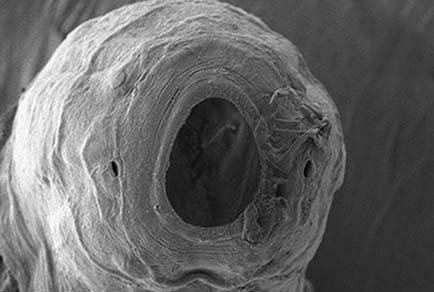Abstract
Arthrostoma supriatnai sp. nov. was described from Mydaus javanensis obtained from Mount Ciremai, Java, Indonesia. It is characterized by having a buccal capsule with ten articulated plates including a pair of additional lateral plates. To date, the genus Arthrostoma consists of eleven species that are native to Asia. Of them, only A. miyazankiense and A. tunkanati have ten articulated plates including the lateral plates. However, the present species has a much stouter body, being readily distinguishable from these two species. Moreover, its male has much shorter spicules than A. miyazakiense, and an arrow-shaped gubernaculum, differing from A. tunkanati, in which gubernaculum is distally bifid. In the female, the present species is readily distinguished from these two species in the shape and number of vulval swellings.
References
- American Society of Mammalogists (1987) Acceptable field methods in mammalogy: Preliminary gudelines approved by the American Society. Journal of Mammalogy, 68 (Supplement 4), 1–18.
- Cameron, T.W.M. (1927) On Arthrostoma felineum gen. et sp. nov., a parasite of cats. Journal of Helminthology, 5 (3), 143–148. https://doi.org/10.1017/S0022149X00002200
- Cheng, Y. & Shen, S. (1982) A new species of nematode of the genus Arthrostoma (Strongyloidea: Ancylosiomatidae). Acta Zooiaxonomica Sinica, 7, 127–129.
- Hodda, M. (2022) Phylum Nematoda: a classification, catalogue and index of valid genera, with a census of valid species. Zootaxa, 5114 (1), 1–289. https://doi.org/10.11646/zootaxa.5114.1.1
- Hotez, P.J. (2011) Hookworm infections. In: Guerrant, R.L., Walker, D.H. & Weller, P.F (Eds.), Tropical Infectious Diseases: Principles, Pathogens and Practice. Elsevier, Edinburgh, London, New York, Oxford, Philadelphia, St Louis, Sydney and Toronto, pp. 799–804. https://doi.org/10.1016/B978-0-7020-3935-5.00116-6
- Hwang, Y.T. & Larivière, S. (2003) Mydaus javanensis. Mammalian Species, 723, 1–3. https://doi.org/10.1644/0.723.1
- Hwang, Y.T. & Larivière, S. (2004) Mydaus marchei. Mammalian Species, 757, 1–3. https://doi.org/10.1644/757
- Inglis, W.G. & Ogden, C.G. (1965) Descriptions of some strongyles (Nematoda) from mammals in East Nepal: with records of other parasitic nematodes. Bulletin of the British Museum (Natural History), Series D (Zoology), 3 (7), 231–245. https://doi.org/10.5962/bhl.part.16751
- Kou, C.C. (1958) Studies on parasitic nematodes of mammals from Canton. I. Some new species from Paradoxurus minor exitus Schwarj, Paguma larvata larvata (Hamilton Smith) and Manis pentadactyla aurita Hodgson. Acta Zoologica Sinica, 10, 60–72. [in Chinnese]
- Lichtenfels, J.R. (1980) No. 8. Keys to genera of the Superfamilies Ancylostomatoidea and Diaphanocephaloidea. In: Anderson, R.C., Chabaud, A.G. & Willmott, S. (Eds.), CIH Keys to the Nematode Parasites of Vertebrates. Commonwealth Agricultural Bureaux, Farnham Royal, Buckinghamshire, 26 pp.
- Maplestone, P.A. (1931) Parasitic nematodes obtained from animals dying in the Calcutta Zoological Gardens. Parts 4–8. Records of the Indian Museum, 33, 71–171. https://doi.org/10.26515/rzsi/v33/i2/1931/162495
- Samejima, H., Meijaard, E, Duckworth, J.W., Yasuma, S, Hearn, A.J., Ross, J., Mohamed, A., Alfred, R., Bernard, H., Boonratana, R, Pilgrim, J.D., Eaton, J, Belant, J.L, Kramer-Schadt, S., Semiadi G. & Wilting, A. (2016) Predicted distribution of the Sunda Stink-badger Mydaus javanensis (Mammalia: Carnivora: Mephitidae) on Borneo. Raffles Bulletin of Zoology, 33 (Supplement), 61–70.
- Sandground, J.H. (1933) Report on the nematode parasites collected by the Kelley-Roosevelts expedition to Indo-China with descriptions of several new species. Zeitschrift für Parasitenkunde, 5, 542–583. https://doi.org/10.1007/BF02121363
- Sato, H. & Suzuki, K. (2006) Gastrointestinal helminths of feral raccoons (Procyon lotor) in Wakayama Prefecture, Japan. Journal of Veterinary Medical Science, 68 (4), 311–318. https://doi.org/10.1292/jvms.68.311
- Sato, H., Ihama, Y., Inaba, T., Yagisawa, M. & Kamiya, H. (1999) Helminth fauna of carnivores distributed in North-western Tohoku, Japan, with special reference to Mesocestoides paucitesticulus and Brachylaima tokudai. Journal of Veterinary Medical Science, 61 (12), 1339–1342. https://doi.org/10.1292/jvms.61.1339
- Schmidt, G.D. & Kuntz, R.E. (1968) Nematode parasites of Oceanica. III. Arthrostoma vampira sp. n., with a reconsideration of those hookworms having articulated buccal capsule. Journal of Parasitology, 54 (2), 372–376. https://doi.org/10.2307/3276955
- Wilson, D.E. & Reeder, D.M. (Eds.) (2005) Mammal Species of the World: A Taxonomic and Geographic Reference. 3rd Edition. Johns Hopkins University Press, Baltimore, Maryland, 2142 pp.
- Wilting, A., Duckworth, J.W., Meijaard, E., Ross, J., Hearn, A. & Ario, A. (2015) Mydaus javanensis. The IUCN Red List of Threatened Species, 2015, e.T41628A45209955. https://doi.org/10.2305/IUCN.UK.2015-4.RLTS.T41628A45209955.en
- Witenberg, G. (1934) Parasitic worms of dogs and cats in Palestine. Veterinary Record, 14, 232–239.
- Xie, Y., Hoberg, E.P., Yang, Z., Joseph, F., Urban, Jr, J.F. & Yang, G. (2017) Ancylostoma ailuropodae n. sp. (Nematoda: Ancylostomatidae), a new hookworm parasite isolated from wild giant pandas in Southwest China. Parasites and Vectors, 10 (1), 277. https://doi.org/10.1186/s13071-017-2209-2
- Yagisawa, M. (1978) Studies on zoonotic helminths from mammals in northern Honshu, Japan. Hirosaki Medical Journal, 30, 239–284.
- Yasuda, N., Akuzawa, M., Maruyama, H., Izawa, M. & Doi, T. (1992) Experimental infection to domestic cats with Arthrostoma hunanensis derived from the feces of Tsushima leopard cat (Felis bengalensis euptilura). Japanese Journal of Parasitology, 41, 496–504.
- Yasuda, N., Akuzawa, M., Maruyama, H., Izawa, M. & Doi, T. (1993) Helminths of the Tsushima leopard cat (Felis bengalensis euptilura). Journal of Wildlife Diseases, 29, 153–155. https://doi.org/10.7589/0090-3558-29.1.153
- Yoshida, Y. & Arizono, N. (1976) Arthrostoma miyazakiense (Nagayosi, 1955) comb. n., a parasite of the raccoon-like dog, Nyctereutes procyonoides, with a key to the genus Arthrostoma (Nematoda: Ancylostomatidae). Journal of Parasitology, 62 (5), 766–770. https://doi.org/10.2307/3278958


